| November 1, 2006
RCA Living Stereo
High-Resolution Opera
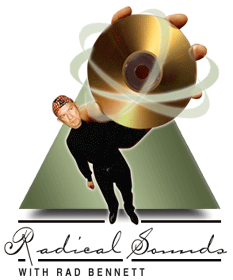 With all the classical titles
that have been released on SACD and DVD-Audio, it’s surprising how few mainstream
operas have been released in high resolution. Decca did a La Bohème, Harmonia
Mundi The Marriage of Figaro, and DG both Don Giovanni and La Traviata,
but most SACD opera releases have been of less-well-known titles from the Baroque period
and the 20th century. With all the classical titles
that have been released on SACD and DVD-Audio, it’s surprising how few mainstream
operas have been released in high resolution. Decca did a La Bohème, Harmonia
Mundi The Marriage of Figaro, and DG both Don Giovanni and La Traviata,
but most SACD opera releases have been of less-well-known titles from the Baroque period
and the 20th century.
BMG’s recent foray into the opera catalog of RCA
Living Stereo is quite welcome. It includes Turandot [82624], La Traviata
[82623], La Bohème [82621], and Madama Butterfly [82622], all among the
most beloved operas of all time. These were recorded in Italy, one per year from 1959 to
1962, using the forces of the Rome Opera and casts that included tried and true veterans
such as Jussi Bjoerling, Richard Tucker, and Robert Merrill, and such dazzling newcomers
as Anna Moffo and Leontyne Price. RCA’s "house conductor," Erich Leinsdorf,
led three of these recordings.
Among BMG’s first wave of RCA Living Stereo operas (I
say that hoping for a second wave that will include Tosca, the most glaring
omission here) are some landmark performances. Turandot featured as the icy
princess Birgit Nilsson, who then only recently became a star, in a role that would become
a signature for her. Anna Moffo and Leontyne Price, both new stars, were recorded in their
own respective signature roles of Violetta and Cio-Cio San. Artistically, the best of
these recordings are Turandot, Traviata, and Butterfly; Bohème
seems to me a bit of a misfire -- nothing particularly wrong with it, but nothing
memorable either. La Bohème is also the one that sounds less than great. The sound
is weighted heavily toward the right channel, and the vocal-orchestral balance seems off
at many points.
All of these operas appear on SACD in three-channel mixes
(left, center, right), which helps clarify things a lot. In early stereo opera recordings,
producers often had singers change position to re-create the action onstage. RCA had its
famous "checkerboard" grid, on which singers were moved about like chess pieces.
The three-channel sound helps focus the location of each singer much better than in the
two-channel versions. Because these are all hybrid multichannel SACD/CDs, you can compare
by playing the new mixes with the two-channel SACD and CD tracks.
Turandot is the best-sounding of the lot. The voices
are clear and the sounds of the exotic percussion instruments are clean, with great
presence. The stereo spread is excellent, and the singers and instruments are perfectly
balanced. Except for a weak representation of the upper percussion instruments, Madama
Butterfly, too, is excellent, as is La Traviata, in which the crowd scenes are
particularly well handled.
Each opera is packaged in a slimline two-disc case. In a
sign of the times, there are no librettos, though a link is provided to a website from
which you can download them. It’s wonderful to have these magnificent voices and
wonderful performances available in hi-rez, sounding better than ever. Now, on to Tosca,
Otello, and La Forza del Destino!
These RCA Living Stereo operas would make great gifts. Here
are six more high-resolution discs to close out 2006 that could serve the same purpose:
Conciertango
Piazzolla: Double Concerto for Guitar and Bandoneón
Tirao: Conciertango Buenos Aires for Guitar and Orchestra
Lacagnina: Concerto Serenata (Omaggio a Astor Piazzolla) for Guitar and String
Orchestra
Edoardo Catemario, guitar; Michael Zisman, bandoneón; Orchestra Vincenzo Galilei; Nicola
Paszkowski, conductor.
Arts 47728-8, Hybrid Multichannel SACD.
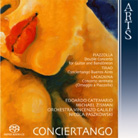 Ah, the tango --
scintillating, elegant, undulating, and sensuous, a dance to involve the whole spirit,
body, and soul of dancers and performers. Nowhere is it felt more strongly than in the
music of Astor Piazzolla, whose name has become synonymous with tango. His Double
Concerto on this engaging disc presents not only the solo guitar, but also the small
accordion used for the tango, the bandoneón. Cacho Tirao’s Conciertango Buenos
Aires for guitar features the folk music of his native Argentina. The first two
movements comprise gentle melodies and subtle rhythms, but in the last the tango demands
to be heard, the music growing more strident and dissonant. The Italian composer Olivero
Lacagnina’s Concerto Serenata has insistent, passionate tango rhythms that are
a fitting tribute to Piazzolla. The soloists, orchestra, and conductor seem to have this
music in their blood, and toss off its difficult passages with flair and ease. The
readings sound natural and beguiling, and the engineering is first rate. The soloists are
placed up front, the orchestra behind them, and all players are heard with a singular
clarity, the sound also conveying the music’s warmth. The soundstage is deep but
narrow, though the rear-channel reverb seems just right. If you’re looking for
something new that will prove so ingratiating it quickly becomes familiar, this disc is
it. Ah, the tango --
scintillating, elegant, undulating, and sensuous, a dance to involve the whole spirit,
body, and soul of dancers and performers. Nowhere is it felt more strongly than in the
music of Astor Piazzolla, whose name has become synonymous with tango. His Double
Concerto on this engaging disc presents not only the solo guitar, but also the small
accordion used for the tango, the bandoneón. Cacho Tirao’s Conciertango Buenos
Aires for guitar features the folk music of his native Argentina. The first two
movements comprise gentle melodies and subtle rhythms, but in the last the tango demands
to be heard, the music growing more strident and dissonant. The Italian composer Olivero
Lacagnina’s Concerto Serenata has insistent, passionate tango rhythms that are
a fitting tribute to Piazzolla. The soloists, orchestra, and conductor seem to have this
music in their blood, and toss off its difficult passages with flair and ease. The
readings sound natural and beguiling, and the engineering is first rate. The soloists are
placed up front, the orchestra behind them, and all players are heard with a singular
clarity, the sound also conveying the music’s warmth. The soundstage is deep but
narrow, though the rear-channel reverb seems just right. If you’re looking for
something new that will prove so ingratiating it quickly becomes familiar, this disc is
it.
Elgar: Enigma Variations
Britten: The Young Person’s Guide to the Orchestra, Four Sea Interludes
from Peter Grimes
Cincinnati Symphony; Paavo Järvi, conductor.
Telarc SACD-60660, Hybrid Multichannel SACD.
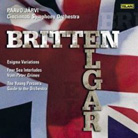 In the past two decades, the Cincinnati
Symphony has become a world-class orchestra. It is fitting, then, that it record Benjamin
Britten’s The Young Person’s Guide to the Orchestra, originally composed
for a 1946 educational film, Instruments of the Orchestra, when it was conducted by
Sir Malcolm Sargent. The work gives every section of the orchestra, and most of the
first-chair players, chances to shine, and that is exactly what the Cincinnati players do
here. Only Britten’s own recording, with the London Symphony, is better. Conductor
Paavo Järvi handles the Four Sea Interludes from Britten’s Peter Grimes
with dramatic flair and an ear for bringing out different orchestral colors. Elgar’s Enigma
Variations is absolutely idiomatic and first rate until the finale, which is a bit
slow and lacking in shape. The sound is what we’ve come to expect from Telarc’s
Cincinnati sessions: rich, warm, and full, with great clarity, a wide, deep soundstage,
and just the right amount of reverb. The timpani in The Young Person’s
Guide are awesome, and the organ in the finale of the Elgar makes its presence known
without sounding like a solo instrument. In the past two decades, the Cincinnati
Symphony has become a world-class orchestra. It is fitting, then, that it record Benjamin
Britten’s The Young Person’s Guide to the Orchestra, originally composed
for a 1946 educational film, Instruments of the Orchestra, when it was conducted by
Sir Malcolm Sargent. The work gives every section of the orchestra, and most of the
first-chair players, chances to shine, and that is exactly what the Cincinnati players do
here. Only Britten’s own recording, with the London Symphony, is better. Conductor
Paavo Järvi handles the Four Sea Interludes from Britten’s Peter Grimes
with dramatic flair and an ear for bringing out different orchestral colors. Elgar’s Enigma
Variations is absolutely idiomatic and first rate until the finale, which is a bit
slow and lacking in shape. The sound is what we’ve come to expect from Telarc’s
Cincinnati sessions: rich, warm, and full, with great clarity, a wide, deep soundstage,
and just the right amount of reverb. The timpani in The Young Person’s
Guide are awesome, and the organ in the finale of the Elgar makes its presence known
without sounding like a solo instrument.
The World’s Greatest Audiophile Vocal Recordings
Rebecca Pidgeon, Livingston Taylor, Valerie Joyce, Christy Baron, Rosa Passos, Kenny
Rankin, Sara K, Marta Gomez, Laverne Butler, Xiomara, Carlos Franzetti, Ana Caram.
Chesky SACD323, Hybrid Multichannel SACD.
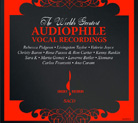 David Chesky has announced
that, beginning in 2007, all Chesky recordings will be released as hybrid SACDs. If they
all sound as good as this one, that will be fine by me -- there’s no reason for
record stores to have to stock double inventories; a single release including CD and SACD
layers serves all needs. But however low this sampler’s price, it will prove
expensive -- once these samples are heard, you’ll want the complete discs from which
they’ve been selected. My favorites here are Valerie Joyce’s sultry rendition of
"Fever," Rosa Passos’ seductively swaying "Girl from Ipanema,"
and Kenny Rankin’s incredible "’Round Midnight," accompanied by double
bass alone. But there’s not a bad track on the entire disc -- each is a winner. The
sound? Chesky says, "We give you the purest, most natural recordings made today with
a single-point microphone, using the world’s finest custom-made electronics,"
and I won’t argue with that. No matter which of these singers you’re listening
to, the sound is entirely natural. It’s like distinguishing among many different
singers heard in as many live venues. Chesky doesn’t believe in using a center
channel -- these recordings are all 4.0 -- but the center-channel "ghost" image
is solid. The many bass solos (the bassists include Ron Carter) on The World’s
Greatest Audiophile Vocal Recordings will let you know, depending on your
system’s low-bass crossover point, whether or not your subwoofer balance is right. My
only complaint about this sampler is that it is short. Chesky also has a series of SACDs,
called the New York Sessions, all recorded at St. Peter’s Church in Chelsea,
Manhattan, in completely natural, unfettered sound. I find the George Mraz Trio’s
breezy Manhattan [SACD310] the most accessible; try that and go from there. David Chesky has announced
that, beginning in 2007, all Chesky recordings will be released as hybrid SACDs. If they
all sound as good as this one, that will be fine by me -- there’s no reason for
record stores to have to stock double inventories; a single release including CD and SACD
layers serves all needs. But however low this sampler’s price, it will prove
expensive -- once these samples are heard, you’ll want the complete discs from which
they’ve been selected. My favorites here are Valerie Joyce’s sultry rendition of
"Fever," Rosa Passos’ seductively swaying "Girl from Ipanema,"
and Kenny Rankin’s incredible "’Round Midnight," accompanied by double
bass alone. But there’s not a bad track on the entire disc -- each is a winner. The
sound? Chesky says, "We give you the purest, most natural recordings made today with
a single-point microphone, using the world’s finest custom-made electronics,"
and I won’t argue with that. No matter which of these singers you’re listening
to, the sound is entirely natural. It’s like distinguishing among many different
singers heard in as many live venues. Chesky doesn’t believe in using a center
channel -- these recordings are all 4.0 -- but the center-channel "ghost" image
is solid. The many bass solos (the bassists include Ron Carter) on The World’s
Greatest Audiophile Vocal Recordings will let you know, depending on your
system’s low-bass crossover point, whether or not your subwoofer balance is right. My
only complaint about this sampler is that it is short. Chesky also has a series of SACDs,
called the New York Sessions, all recorded at St. Peter’s Church in Chelsea,
Manhattan, in completely natural, unfettered sound. I find the George Mraz Trio’s
breezy Manhattan [SACD310] the most accessible; try that and go from there.
Gloryland: Folk Songs, Spirituals, Gospel Hymns of
Hope & Glory
Anonymous 4: Marsha Genensky, Susan Hellauer, Jacqueline Horner, Johanna Maria Rose; Darol
Anger, fiddle, guitar, mandocello; Mike Marshall, mandolin, mandocello, guitar.
Harmonia Mundi HMU 907400, Hybrid Multichannel SACD.
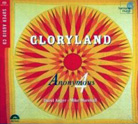 The four women who comprise Anonymous 4
are best known for their forays into medieval music, most importantly that of Hildegard
von Bingen. But the talented quartet is ever on the lookout for good music suitable for
them to perform, and the Anglo-American folk songs and gospel hymns provide fertile
repertory. The disc begins with a three-part shape-note tune, one of three here,
"I’m on My Journey Home," which seems written for A4 to sing. They capture
perfectly the vibrant, ringing nature of this deceptively simple song. One of the more
interesting aspects of the disc is following a tune as it pops up in various guises. The
melody of "Wayfaring Stranger" can be heard in "You Fair and Pretty
Ladies" as well as in the mesmerizing "Parting Friends." Most of the songs
are sung a cappella, but a few benefit from the additions of Darol Anger and Mike
Marshall, who variously play fiddle, mandolin, mandocello, and guitar. The sound is
sonorous and clean in two-channel stereo, while the multichannel tracks add warmth and
detail without sacrificing the simplicity that makes this disc so appealing. The four women who comprise Anonymous 4
are best known for their forays into medieval music, most importantly that of Hildegard
von Bingen. But the talented quartet is ever on the lookout for good music suitable for
them to perform, and the Anglo-American folk songs and gospel hymns provide fertile
repertory. The disc begins with a three-part shape-note tune, one of three here,
"I’m on My Journey Home," which seems written for A4 to sing. They capture
perfectly the vibrant, ringing nature of this deceptively simple song. One of the more
interesting aspects of the disc is following a tune as it pops up in various guises. The
melody of "Wayfaring Stranger" can be heard in "You Fair and Pretty
Ladies" as well as in the mesmerizing "Parting Friends." Most of the songs
are sung a cappella, but a few benefit from the additions of Darol Anger and Mike
Marshall, who variously play fiddle, mandolin, mandocello, and guitar. The sound is
sonorous and clean in two-channel stereo, while the multichannel tracks add warmth and
detail without sacrificing the simplicity that makes this disc so appealing.
Stanford: The Revenge: A Ballad of the Fleet; Songs
of the Sea; Songs of the Fleet
Gerald Finley, baritone; BBC National Chorus and Orchestra of Wales; Richard Hickox,
conductor.
Chandos CHSA 5043, Hybrid Multichannel SACD.
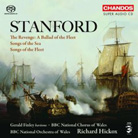 Sir Charles Villiers Stanford
(1852-1924) was no mariner, but, like many natives of his island nation of Great Britain,
he was attracted to songs about the sea and the navy that sailed on it. The Revenge: A
Ballad of the Fleet, scored for chorus and orchestra and the earliest composition on
this generously filled SACD, was written on commission in 1886 to texts by Tennyson
describing a mighty 1591 battle with the Spanish Fleet. After the turn of the century,
Stanford came to know the poet Henry Newbolt and set many of his verses in two sets of
songs for baritone, chorus, and orchestra. This stalwart material can bristle with
prideful bravura: "Stand by to reckon up you battleships, / Ten, twenty, thirty there
they go. / Brag about your cruisers like Leviathans / A thousand men apiece down
below." It can also express noble consolation for the fallen: "Mother, with
unbowed head / Hear thou across the sea / The farewell of the dead. / The dead who died
for thee." Sir Charles Villiers Stanford
(1852-1924) was no mariner, but, like many natives of his island nation of Great Britain,
he was attracted to songs about the sea and the navy that sailed on it. The Revenge: A
Ballad of the Fleet, scored for chorus and orchestra and the earliest composition on
this generously filled SACD, was written on commission in 1886 to texts by Tennyson
describing a mighty 1591 battle with the Spanish Fleet. After the turn of the century,
Stanford came to know the poet Henry Newbolt and set many of his verses in two sets of
songs for baritone, chorus, and orchestra. This stalwart material can bristle with
prideful bravura: "Stand by to reckon up you battleships, / Ten, twenty, thirty there
they go. / Brag about your cruisers like Leviathans / A thousand men apiece down
below." It can also express noble consolation for the fallen: "Mother, with
unbowed head / Hear thou across the sea / The farewell of the dead. / The dead who died
for thee."
Canadian baritone Gerald Finley is just the right artist to
sing these songs -- his big, sonorous voice is also well-focused enough to convey the full
meaning of the texts. The wonderful choral singing of the BBC National Chorus and
Orchestra of Wales lets one know why Wales is known for its songsters, and the orchestra
plays with precision and good tone. Richard Hickox guides these fine performers with a
sure and knowing hand, capturing all the swagger and nobility of such favorites as
"Drake’s Drum" and "The Old Superb." The sound is big, bold, and
clear, and the SACD tracks add just the right amount of reverb to give a clear impression
of a largish hall.
C.P.E. Bach: Symphonies 1-4; Cello Concerto in
A
Alison McGillivray, cello; The English Concert; Andrew Manze, director.
Harmonia Mundi HMU 907403, Hybrid Multichannel SACD.
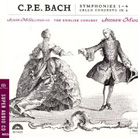 The symphonies of Carl Philip Emanuel
Bach seem so brash and daring that one is surprised to find out he was 61 when he wrote
them. Rapid dynamic changes, abrupt modulations, and fleet virtuoso passages for strings
make this thrilling music, particularly in these incredibly bold readings by Andrew Manze
and the English Concert. The violins play the many swirling figures as if they were the
winter wind ripping down the last leaves of fall. The harpsichord is used to provide
color, as are the flutes and oboes. But the music isn’t all pounding pulses. The
middle movement of each symphony gives the players a chance to provide lustrous tone for
soulful moments of greater repose, and the cello concerto is more sedate than the
symphonies while never lacking for imaginative passages of great energy. Alison
McGillivray, principal cellist with the English Concert for three years, plays with
finesse and controlled abandon. The sound is much like that of Manze’s other
recordings for Harmonia Mundi: rich, very big, yet highly detailed. The bass line is well
defined, and the upper strings have power and punch while never sounding brittle. The
harpsichord is balanced just right, and the rear channels contribute to a sense of
presence and immediacy at which the two-channel version can only hint. The symphonies of Carl Philip Emanuel
Bach seem so brash and daring that one is surprised to find out he was 61 when he wrote
them. Rapid dynamic changes, abrupt modulations, and fleet virtuoso passages for strings
make this thrilling music, particularly in these incredibly bold readings by Andrew Manze
and the English Concert. The violins play the many swirling figures as if they were the
winter wind ripping down the last leaves of fall. The harpsichord is used to provide
color, as are the flutes and oboes. But the music isn’t all pounding pulses. The
middle movement of each symphony gives the players a chance to provide lustrous tone for
soulful moments of greater repose, and the cello concerto is more sedate than the
symphonies while never lacking for imaginative passages of great energy. Alison
McGillivray, principal cellist with the English Concert for three years, plays with
finesse and controlled abandon. The sound is much like that of Manze’s other
recordings for Harmonia Mundi: rich, very big, yet highly detailed. The bass line is well
defined, and the upper strings have power and punch while never sounding brittle. The
harpsichord is balanced just right, and the rear channels contribute to a sense of
presence and immediacy at which the two-channel version can only hint.
...Rad Bennett
radb@ultraaudio.com

All contents copyright Schneider Publishing Inc., all rights
reserved.
Any reproduction, without permission, is prohibited.
Ultra Audio is part of the SoundStage! Network.
A world of websites and publications for audio, video, music, and movie enthusiasts. |

 With all the classical titles
that have been released on SACD and DVD-Audio, it’s surprising how few mainstream
operas have been released in high resolution. Decca did a La Bohème, Harmonia
Mundi The Marriage of Figaro, and DG both Don Giovanni and La Traviata,
but most SACD opera releases have been of less-well-known titles from the Baroque period
and the 20th century.
With all the classical titles
that have been released on SACD and DVD-Audio, it’s surprising how few mainstream
operas have been released in high resolution. Decca did a La Bohème, Harmonia
Mundi The Marriage of Figaro, and DG both Don Giovanni and La Traviata,
but most SACD opera releases have been of less-well-known titles from the Baroque period
and the 20th century.  Ah, the tango --
scintillating, elegant, undulating, and sensuous, a dance to involve the whole spirit,
body, and soul of dancers and performers. Nowhere is it felt more strongly than in the
music of Astor Piazzolla, whose name has become synonymous with tango. His Double
Concerto on this engaging disc presents not only the solo guitar, but also the small
accordion used for the tango, the bandoneón. Cacho Tirao’s Conciertango Buenos
Aires for guitar features the folk music of his native Argentina. The first two
movements comprise gentle melodies and subtle rhythms, but in the last the tango demands
to be heard, the music growing more strident and dissonant. The Italian composer Olivero
Lacagnina’s Concerto Serenata has insistent, passionate tango rhythms that are
a fitting tribute to Piazzolla. The soloists, orchestra, and conductor seem to have this
music in their blood, and toss off its difficult passages with flair and ease. The
readings sound natural and beguiling, and the engineering is first rate. The soloists are
placed up front, the orchestra behind them, and all players are heard with a singular
clarity, the sound also conveying the music’s warmth. The soundstage is deep but
narrow, though the rear-channel reverb seems just right. If you’re looking for
something new that will prove so ingratiating it quickly becomes familiar, this disc is
it.
Ah, the tango --
scintillating, elegant, undulating, and sensuous, a dance to involve the whole spirit,
body, and soul of dancers and performers. Nowhere is it felt more strongly than in the
music of Astor Piazzolla, whose name has become synonymous with tango. His Double
Concerto on this engaging disc presents not only the solo guitar, but also the small
accordion used for the tango, the bandoneón. Cacho Tirao’s Conciertango Buenos
Aires for guitar features the folk music of his native Argentina. The first two
movements comprise gentle melodies and subtle rhythms, but in the last the tango demands
to be heard, the music growing more strident and dissonant. The Italian composer Olivero
Lacagnina’s Concerto Serenata has insistent, passionate tango rhythms that are
a fitting tribute to Piazzolla. The soloists, orchestra, and conductor seem to have this
music in their blood, and toss off its difficult passages with flair and ease. The
readings sound natural and beguiling, and the engineering is first rate. The soloists are
placed up front, the orchestra behind them, and all players are heard with a singular
clarity, the sound also conveying the music’s warmth. The soundstage is deep but
narrow, though the rear-channel reverb seems just right. If you’re looking for
something new that will prove so ingratiating it quickly becomes familiar, this disc is
it. In the past two decades, the Cincinnati
Symphony has become a world-class orchestra. It is fitting, then, that it record Benjamin
Britten’s The Young Person’s Guide to the Orchestra, originally composed
for a 1946 educational film, Instruments of the Orchestra, when it was conducted by
Sir Malcolm Sargent. The work gives every section of the orchestra, and most of the
first-chair players, chances to shine, and that is exactly what the Cincinnati players do
here. Only Britten’s own recording, with the London Symphony, is better. Conductor
Paavo Järvi handles the Four Sea Interludes from Britten’s Peter Grimes
with dramatic flair and an ear for bringing out different orchestral colors. Elgar’s Enigma
Variations is absolutely idiomatic and first rate until the finale, which is a bit
slow and lacking in shape. The sound is what we’ve come to expect from Telarc’s
Cincinnati sessions: rich, warm, and full, with great clarity, a wide, deep soundstage,
and just the right amount of reverb. The timpani in The Young Person’s
Guide are awesome, and the organ in the finale of the Elgar makes its presence known
without sounding like a solo instrument.
In the past two decades, the Cincinnati
Symphony has become a world-class orchestra. It is fitting, then, that it record Benjamin
Britten’s The Young Person’s Guide to the Orchestra, originally composed
for a 1946 educational film, Instruments of the Orchestra, when it was conducted by
Sir Malcolm Sargent. The work gives every section of the orchestra, and most of the
first-chair players, chances to shine, and that is exactly what the Cincinnati players do
here. Only Britten’s own recording, with the London Symphony, is better. Conductor
Paavo Järvi handles the Four Sea Interludes from Britten’s Peter Grimes
with dramatic flair and an ear for bringing out different orchestral colors. Elgar’s Enigma
Variations is absolutely idiomatic and first rate until the finale, which is a bit
slow and lacking in shape. The sound is what we’ve come to expect from Telarc’s
Cincinnati sessions: rich, warm, and full, with great clarity, a wide, deep soundstage,
and just the right amount of reverb. The timpani in The Young Person’s
Guide are awesome, and the organ in the finale of the Elgar makes its presence known
without sounding like a solo instrument. David Chesky has announced
that, beginning in 2007, all Chesky recordings will be released as hybrid SACDs. If they
all sound as good as this one, that will be fine by me -- there’s no reason for
record stores to have to stock double inventories; a single release including CD and SACD
layers serves all needs. But however low this sampler’s price, it will prove
expensive -- once these samples are heard, you’ll want the complete discs from which
they’ve been selected. My favorites here are Valerie Joyce’s sultry rendition of
"Fever," Rosa Passos’ seductively swaying "Girl from Ipanema,"
and Kenny Rankin’s incredible "’Round Midnight," accompanied by double
bass alone. But there’s not a bad track on the entire disc -- each is a winner. The
sound? Chesky says, "We give you the purest, most natural recordings made today with
a single-point microphone, using the world’s finest custom-made electronics,"
and I won’t argue with that. No matter which of these singers you’re listening
to, the sound is entirely natural. It’s like distinguishing among many different
singers heard in as many live venues. Chesky doesn’t believe in using a center
channel -- these recordings are all 4.0 -- but the center-channel "ghost" image
is solid. The many bass solos (the bassists include Ron Carter) on The World’s
Greatest Audiophile Vocal Recordings will let you know, depending on your
system’s low-bass crossover point, whether or not your subwoofer balance is right. My
only complaint about this sampler is that it is short. Chesky also has a series of SACDs,
called the New York Sessions, all recorded at St. Peter’s Church in Chelsea,
Manhattan, in completely natural, unfettered sound. I find the George Mraz Trio’s
breezy Manhattan [SACD310] the most accessible; try that and go from there.
David Chesky has announced
that, beginning in 2007, all Chesky recordings will be released as hybrid SACDs. If they
all sound as good as this one, that will be fine by me -- there’s no reason for
record stores to have to stock double inventories; a single release including CD and SACD
layers serves all needs. But however low this sampler’s price, it will prove
expensive -- once these samples are heard, you’ll want the complete discs from which
they’ve been selected. My favorites here are Valerie Joyce’s sultry rendition of
"Fever," Rosa Passos’ seductively swaying "Girl from Ipanema,"
and Kenny Rankin’s incredible "’Round Midnight," accompanied by double
bass alone. But there’s not a bad track on the entire disc -- each is a winner. The
sound? Chesky says, "We give you the purest, most natural recordings made today with
a single-point microphone, using the world’s finest custom-made electronics,"
and I won’t argue with that. No matter which of these singers you’re listening
to, the sound is entirely natural. It’s like distinguishing among many different
singers heard in as many live venues. Chesky doesn’t believe in using a center
channel -- these recordings are all 4.0 -- but the center-channel "ghost" image
is solid. The many bass solos (the bassists include Ron Carter) on The World’s
Greatest Audiophile Vocal Recordings will let you know, depending on your
system’s low-bass crossover point, whether or not your subwoofer balance is right. My
only complaint about this sampler is that it is short. Chesky also has a series of SACDs,
called the New York Sessions, all recorded at St. Peter’s Church in Chelsea,
Manhattan, in completely natural, unfettered sound. I find the George Mraz Trio’s
breezy Manhattan [SACD310] the most accessible; try that and go from there. The four women who comprise Anonymous 4
are best known for their forays into medieval music, most importantly that of Hildegard
von Bingen. But the talented quartet is ever on the lookout for good music suitable for
them to perform, and the Anglo-American folk songs and gospel hymns provide fertile
repertory. The disc begins with a three-part shape-note tune, one of three here,
"I’m on My Journey Home," which seems written for A4 to sing. They capture
perfectly the vibrant, ringing nature of this deceptively simple song. One of the more
interesting aspects of the disc is following a tune as it pops up in various guises. The
melody of "Wayfaring Stranger" can be heard in "You Fair and Pretty
Ladies" as well as in the mesmerizing "Parting Friends." Most of the songs
are sung a cappella, but a few benefit from the additions of Darol Anger and Mike
Marshall, who variously play fiddle, mandolin, mandocello, and guitar. The sound is
sonorous and clean in two-channel stereo, while the multichannel tracks add warmth and
detail without sacrificing the simplicity that makes this disc so appealing.
The four women who comprise Anonymous 4
are best known for their forays into medieval music, most importantly that of Hildegard
von Bingen. But the talented quartet is ever on the lookout for good music suitable for
them to perform, and the Anglo-American folk songs and gospel hymns provide fertile
repertory. The disc begins with a three-part shape-note tune, one of three here,
"I’m on My Journey Home," which seems written for A4 to sing. They capture
perfectly the vibrant, ringing nature of this deceptively simple song. One of the more
interesting aspects of the disc is following a tune as it pops up in various guises. The
melody of "Wayfaring Stranger" can be heard in "You Fair and Pretty
Ladies" as well as in the mesmerizing "Parting Friends." Most of the songs
are sung a cappella, but a few benefit from the additions of Darol Anger and Mike
Marshall, who variously play fiddle, mandolin, mandocello, and guitar. The sound is
sonorous and clean in two-channel stereo, while the multichannel tracks add warmth and
detail without sacrificing the simplicity that makes this disc so appealing. Sir Charles Villiers Stanford
(1852-1924) was no mariner, but, like many natives of his island nation of Great Britain,
he was attracted to songs about the sea and the navy that sailed on it. The Revenge: A
Ballad of the Fleet, scored for chorus and orchestra and the earliest composition on
this generously filled SACD, was written on commission in 1886 to texts by Tennyson
describing a mighty 1591 battle with the Spanish Fleet. After the turn of the century,
Stanford came to know the poet Henry Newbolt and set many of his verses in two sets of
songs for baritone, chorus, and orchestra. This stalwart material can bristle with
prideful bravura: "Stand by to reckon up you battleships, / Ten, twenty, thirty there
they go. / Brag about your cruisers like Leviathans / A thousand men apiece down
below." It can also express noble consolation for the fallen: "Mother, with
unbowed head / Hear thou across the sea / The farewell of the dead. / The dead who died
for thee."
Sir Charles Villiers Stanford
(1852-1924) was no mariner, but, like many natives of his island nation of Great Britain,
he was attracted to songs about the sea and the navy that sailed on it. The Revenge: A
Ballad of the Fleet, scored for chorus and orchestra and the earliest composition on
this generously filled SACD, was written on commission in 1886 to texts by Tennyson
describing a mighty 1591 battle with the Spanish Fleet. After the turn of the century,
Stanford came to know the poet Henry Newbolt and set many of his verses in two sets of
songs for baritone, chorus, and orchestra. This stalwart material can bristle with
prideful bravura: "Stand by to reckon up you battleships, / Ten, twenty, thirty there
they go. / Brag about your cruisers like Leviathans / A thousand men apiece down
below." It can also express noble consolation for the fallen: "Mother, with
unbowed head / Hear thou across the sea / The farewell of the dead. / The dead who died
for thee." The symphonies of Carl Philip Emanuel
Bach seem so brash and daring that one is surprised to find out he was 61 when he wrote
them. Rapid dynamic changes, abrupt modulations, and fleet virtuoso passages for strings
make this thrilling music, particularly in these incredibly bold readings by Andrew Manze
and the English Concert. The violins play the many swirling figures as if they were the
winter wind ripping down the last leaves of fall. The harpsichord is used to provide
color, as are the flutes and oboes. But the music isn’t all pounding pulses. The
middle movement of each symphony gives the players a chance to provide lustrous tone for
soulful moments of greater repose, and the cello concerto is more sedate than the
symphonies while never lacking for imaginative passages of great energy. Alison
McGillivray, principal cellist with the English Concert for three years, plays with
finesse and controlled abandon. The sound is much like that of Manze’s other
recordings for Harmonia Mundi: rich, very big, yet highly detailed. The bass line is well
defined, and the upper strings have power and punch while never sounding brittle. The
harpsichord is balanced just right, and the rear channels contribute to a sense of
presence and immediacy at which the two-channel version can only hint.
The symphonies of Carl Philip Emanuel
Bach seem so brash and daring that one is surprised to find out he was 61 when he wrote
them. Rapid dynamic changes, abrupt modulations, and fleet virtuoso passages for strings
make this thrilling music, particularly in these incredibly bold readings by Andrew Manze
and the English Concert. The violins play the many swirling figures as if they were the
winter wind ripping down the last leaves of fall. The harpsichord is used to provide
color, as are the flutes and oboes. But the music isn’t all pounding pulses. The
middle movement of each symphony gives the players a chance to provide lustrous tone for
soulful moments of greater repose, and the cello concerto is more sedate than the
symphonies while never lacking for imaginative passages of great energy. Alison
McGillivray, principal cellist with the English Concert for three years, plays with
finesse and controlled abandon. The sound is much like that of Manze’s other
recordings for Harmonia Mundi: rich, very big, yet highly detailed. The bass line is well
defined, and the upper strings have power and punch while never sounding brittle. The
harpsichord is balanced just right, and the rear channels contribute to a sense of
presence and immediacy at which the two-channel version can only hint.